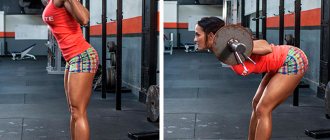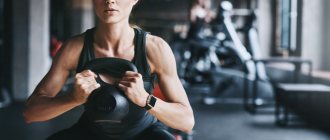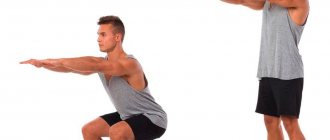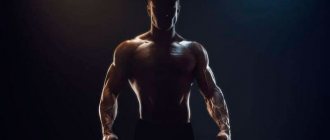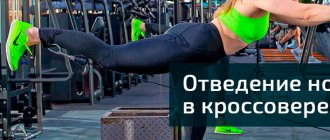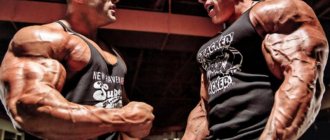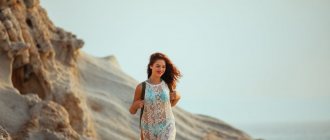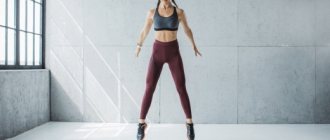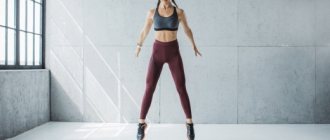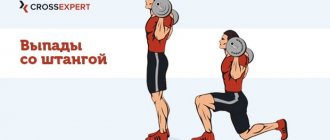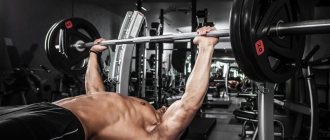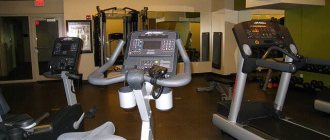Since lunges with a barbell are complex and traumatic exercises, they are recommended to be performed only by experienced athletes who thoroughly know the nuances of the technique. The barbell exercise is performed to strengthen the leg muscles and strengthen the core muscles.
Rules for performing the exercise
- Adjust the bar height to just below shoulder level. Once the height is set and the bar is loaded, stand under the bar with the bar resting on the back of your shoulders.
- Using your legs to push up and your body straight, grab the barbell and lift it off the rack.
- Step away from the counter. As you inhale, take a step forward with your right leg and squat, tensing your thigh muscles. Keep your body straight and maintain balance. Note: Do not allow your knee to go behind your foot during a squat; this will place excessive stress on the knee joint.
- Push up with your heel and, as you exhale, return to the starting position. Repeat the recommended number of times.
This exercise requires the ability to maintain balance. If you have balance problems, either skip this exercise or do it without weights, using only your own body weight.
Variations : There are several ways to perform this exercise:
- The first is to do each subsequent lunge from the other leg (alternating lunges).
- The second is to perform a static lunge, when you start the exercise with your leg already extended forward. In this case, you simply move up and down from your starting position until you complete the recommended number of repetitions. Then repeat on the other leg.
- A more complicated option is walking or lunging. To perform the exercise, it is necessary that the leg that remains behind makes the next lunge forward. This method is intended for advanced level athletes.
Quick instructions: Stand under a rack with the barbell resting on the back of your shoulders. Lift the barbell and step away from the rack. As you inhale, take a step forward with your right foot and squat down. Maintain balance and a straight body. As you exhale, return to the starting position.
Recommendations
- Touching the floor with your standing foot from behind is allowed only if it is soft; you should not hit the kneecap on the floor;
- The movement should be quite deep, especially if the goal is to pump up the gluteal muscles;
- The core and abs should be kept tense in order to maintain the full anatomical relief of the spine;
- It is necessary to check the position of the shin of the leg that is in front. If it does not correspond in any way with the perpendicular, the position should be changed, because this position is dangerous for the ACL
What muscles work when performing lunges with a barbell?
Like classic lunges, lunges with a barbell belong to the group of basic multi-joint exercises that work well the following muscles:
- Gluteal muscles (small, medium and large).
- Quadriceps.
- Extensors of the fascia lata.
- Oblique abdominal muscles.
- Thigh biceps.
In addition to the main muscles, the exercise uses stabilizer muscles:
- Internal oblique muscles of the abdomen.
- Gemini pelvic muscles.
- Piriformis muscles.
Alternative implementations:
Lunges with barbell to the side
Stand straight with the barbell on your shoulders. Legs in a wide position, toes pointing to the sides. As you inhale, lower your body to the side, bending one leg. The other leg remains straight. As you exhale, return to the starting position. Repeat the exercise on the other leg.
Lunges with barbell to the side
Bulgarian barbell squats
Stand with your back to the bench, place the barbell on your shoulders. Place one foot on the bench. As you inhale, slowly squat until your thigh is parallel to the floor. As you exhale, return to the starting position. Repeat as many times as necessary and change legs.
Bulgarian barbell squats
Walking lunges with barbell overhead
Hold the barbell at arm's length. Lunge forward. The knee of the back leg almost touches the floor. Keep your back straight. Push off with the heel of your front foot, rise back up and step forward with the other leg, repeating the lunge.
Walking lunges with barbell overhead
Diagonal lunges back with a barbell
Cross lunges (scissors, curtsy or diagonal) lunges allow you to effectively work the gluteal muscles. Thanks to the crossed position of the legs, similar in technique to a curtsey, the gluteal muscle receives an excellent stretch in the lower phase of the movement.
Performing this exercise with dumbbells, a barbell, or even without weight at all allows you to form rounded, toned buttocks, visually lift them and separate them from the hamstrings.
Back lunges into scissors with weight
Lunges with a barbell back from an elevation
Place the barbell in a power rack at shoulder level. Place a low platform behind you. Place the bar on your upper back. Stand on the platform with both feet. Perform a backward lunge. Lower yourself until your back knee touches the floor. Pause and return to the starting position.
Lunges with a barbell back from an elevation
What are the benefits of squats?
This exercise uses a large number of muscle groups, improving physical fitness and strengthening the cardiovascular system. By doing squats, you can not only achieve beautiful shapes of the gluteal muscle, but also strengthen your back and abdominal muscles. Exercise provides pressure in the chest, which improves the respiratory system, saturating the body with more oxygen.
Is it possible to pump up your buttocks with squats?
Considering that the buttocks are involved in straightening the torso, squats are one of the best methods to pump up your butt well. And the lower the squats, the better the gluteal muscles work and the more effective the exercise is for elastic buttocks.
Important to remember! In order to make your buttocks strong, you need to lift weights. To do this, you need to perform an exercise to grow muscle mass, from 8 to 12 repetitions in one approach.
Between approaches you need a rest of 1 - 2 minutes. The weight of the load should be heavy enough so that you do not have enough strength to perform more than 12 repetitions, this is the effectiveness of the exercise. But it’s better to start mastering the technique with small weights, gradually adding load each workout.
Benefits of Exercise
Consider the following main useful qualities of movement:
- Lunges are a universal exercise that can be performed not only in the gym, but also at home or on the street.
- Regularly performing lunges and controlling your breathing during exercise can strengthen your cardiorespiratory system.
- Works well on quadriceps, develops coordination and works stabilizer muscles.
The technical aspects and advantages of this exercise are qualitatively reviewed in Denis Borisov’s video.
Inclusion in the program
The exercise requires significant coordination of movements, and cannot be performed by a person who has problems in this area. It is usually planned at the very beginning so that the legs are not tired.
In plans designed to increase strength, it is used as a second auxiliary, auxiliary exercise. The set-repetition range can vary from 8-10 repetitions, and the number of approaches can be no more than 5.
At the very initial stage, coordination of movements is still impaired, and it is necessary to practice the movement without weight. This stage can drag on for a long time, and you should not force it.
Common execution errors
When performing classic lunges and lunges with a barbell, you should avoid:
- Lumbar rounding. The back should always be straight.
- Weak fixation of the barbell on the shoulders. In this case, you can injure your lower back or shoulder joints.
- Unfixed weights on the barbell. A mistake is dangerous not only for the athlete, but also for those around him.
- The direction of movement of the knee does not coincide with the direction of the toe of the working leg. This position of the legs is fraught with injury to the knee joint. In addition, this can cause a meniscus tear.
Interesting fact
Lunges have gained popularity not only in strength sports, but also in bodybuilding. Sean Ray, a veteran of the Olympia scene, says that this is an excellent exercise for defining the leg muscles, and it is difficult to replace it with anything else. Domestic bodybuilders also speak positively about lunges.
From the world of women's bodybuilding, lunges are loved by Dana Lynn Bailey and Erin Stern. The movement is included on an ongoing basis in weightlifting and powerlifting programs
Lunges with a barbell for girls
Despite the erroneous judgment, lunges with a barbell will also be useful for the fair sex. This is explained by the fact that multi-joint exercises, to which lunges belong, are considered the most effective. In addition, there are other benefits of barbell lunges for girls:
- high calorie consumption when performing lunges;
- exercise allows you to prevent the consequences of venous stagnation, for example, varicose veins;
- promotes the production of necessary female hormones;
- allows you to pump up your legs and buttocks well;
- exercise allows you to strengthen the muscle corset to prevent injuries.
Alternative Exercises
Contraindications
According to the principle of balance, the benefits of the exercise also entail contraindications to its use. Lunges train muscles well because they allow you to create a significant load on them. But it is precisely this load that can be detrimental to the joints, especially the knees. If you have injuries or any pain in your knees, performing lunges is contraindicated.
If your knees are healthy, to avoid injury while doing exercises, strictly adhere to the technique. Namely, do not bring the knee of the front leg beyond the line of the toe (this creates a traumatic load) and do not knock the knee of the supporting leg on the floor.
Selecting the load accent
In lunges, you can emphasize the load on various muscle groups by positioning the front leg. Let's take a closer look at how you need to place your leg correctly in order to use certain muscle groups:
- Biceps thighs and buttocks. To shift the focus to these muscle groups, it is important to take as wide a step as possible so that the range of motion in the hip joint is maximum. In this case, the knee joint bends less than 90 degrees. Since all the main work is carried out by the extensor of the hip joint.
- Quadriceps. In order to load the quadriceps muscle, you need to take a short step so that the knee bends at an angle of more than 90 degrees. You can maximally load the quadriceps by moving your body forward slightly. At the same time, we maintain a deflection in the lower back.
- Gluteal muscles. Place your working leg as far forward as possible. In this case, the supporting leg should be almost completely straightened and stretched parallel to the floor, and the angle of flexion at the knee should be maximum. This angle will ensure the maximum possible angle of flexion in the hip joint, due to which the necessary stretch is created in the gluteus maximus muscle and it is included in the work.
